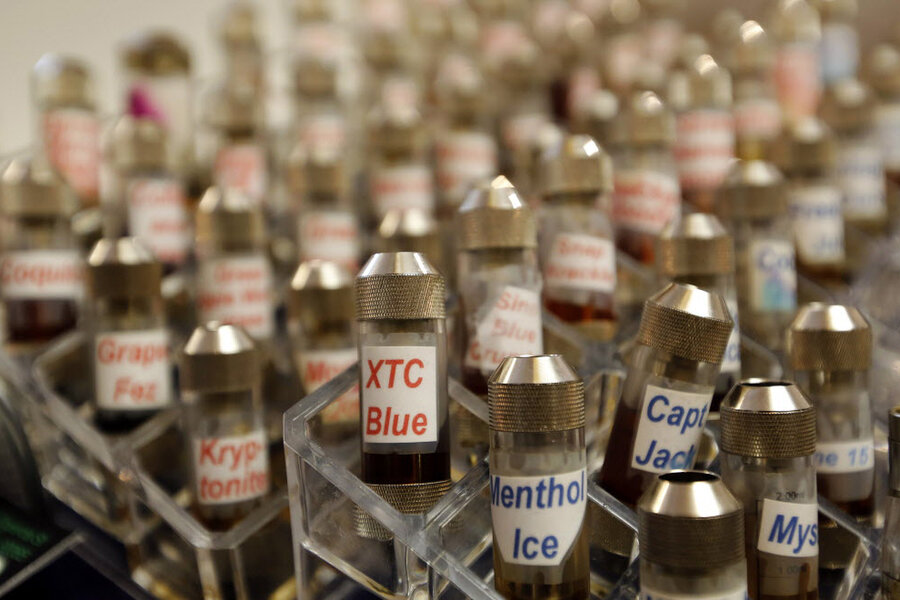Are e-cigarettes a tobacco product? L.A. regulation called 'short-sighted.'
Loading...
| Los Angeles
Do e-cigarettes endanger the health of their users and secondhand inhalers and therefore require strict regulation, or are they a safer alternative to conventional lit cigarettes whose growing popularity should be welcomed?
On Tuesday Los Angeles took the plunge into this national debate, with a unanimous City Council vote to prohibit e-cigarettes wherever regular tobacco products are banned.
If Mayor Eric Garcetti signs the measure, as expected, Los Angeles will have joined the ranks of Chicago, Boston, New York, and another 100-plus municipalities nationwide that have decided to regulate e-cigarette use, even before the Food and Drug Administration (FDA), which regulates tobacco products, has issued e-cigarette regulations of its own.
Supporters of the e-cigarette industry are criticizing the cities’ new laws as hasty, saying there is a lack of conclusive evidence about the long-term health effects of e-cigarette use.
“Lacking concrete scientific evidence, L.A.’s proposal is premature and short-sighted, and would trigger a serious public health disservice by keeping a less harmful product away from existing adult smokers,” says Charles Connor, a consultant to ECIG, an industry trade group, as well as former president of the American Lung Association.
“E-cigarettes do not involve the exhalation of harmful smoke. They do not involve combustion, which has been recognized by the public health community for years as the real danger of a tobacco cigarette,” he says, adding that the lesson is clear: “Different products require different regulations.”
Providing a glimpse of just how contentious this issue is, however, Cynthia Hallett, executive director of Americans Nonsmokers’ Rights Foundation, an advocacy group based in Berkeley, Calif., is quick to rebut the industry position.
E-cigarettes do not just emit “harmless water vapor,” she says. Secondhand e-cigarette aerosol, which she says is “incorrectly called vapor by the industry, contains nicotine, ultrafine particles and low levels of toxins that are known to cause cancer.”
An e-cigarette is essentially a nicotine delivery system, argues pharmacist Tammy Burns, manager of research and tobacco programs at Creighton University in Omaha, Neb., and therefore “that makes it a tobacco product subject to regulation.”
Such a regulation is in fact forthcoming, the FDA says, although the timing is uncertain.
According to the agency’s website, electronic cigarettes are battery-operated products that turn nicotine, which is highly addictive, into a vapor that is inhaled by the user.
“The FDA intends to propose a regulation that would extend the agency’s ‘tobacco product’ authorities – which currently only apply to cigarettes, cigarette tobacco, roll-your-own tobacco, and smokeless tobacco – to other categories of tobacco products that meet the statutory definition of ‘tobacco product,’ ” says an agency spokesperson.
The FDA is quick to note however, that further research is needed to assess the potential public health benefits and risks of electronic cigarettes and other novel tobacco products.
But even as the scientific inquiry continues, some regulation is warranted, suggest many researchers who have spent considerable time studying such issues as youth adoption of smoking and smoking cessation strategies.
The introduction of the e-cigarette and how that is influencing adolescent smoking rates is not well known at this time, says Professor Elizabeth Dowdell, of Villanova University College of Nursing in Philadelphia.
“E-cigarettes can be viewed by this age group as ‘cool’ or ‘neat’ to use because the e-cigarette is new and different,” she says via e-mail. Given the amount of current and past literature on adolescent cigarette smoking that links it to other risk-taking behaviors, she says “it is possible that e-cigarettes will continue to be used in place of traditional cigarettes.”
She cautions that “the addictive nature of nicotine, which is in e-cigarettes, is of concern especially in a young age group that is still developing physically and emotionally.”
Sounding a similarly cautionary note about the perils of addiction is Deric Kenne, assistant professor in the College of Public Health at Kent State University in Ohio, who says via e-mail that if e-cigarettes are attractive to adolescents and young adults, “we could see an increase in use among these populations. This will be especially important if it turns out that e-cigarette use (because of the nicotine) transitions to regular tobacco cigarette use, which we know has numerous negative effects on the health of the public.”
Preliminary results from survey data collected from more than 9,000 college students show that nearly 30 percent were currently using or had tried an e-cigarette, notes Professor Kenne. Of those, 33.5 percent had used e-cigarettes in an effort to stop smoking regular tobacco cigarettes and 27.8 percent had used e-cigarettes because they could “vape” in areas where regular tobacco smoking was banned.
Many tobacco companies have begun moving into the electronic cigarette business.
Miguel Martin, a former executive at Altria, a tobacco company based in Richmond, Va., and now president of LOGIC, the nation’s second largest manufacturer of electronic cigarettes, says his firm has no plans to fight the new laws in court.
He is quick to note that his company has voluntarily adopted a number of strategies that address the question of targeting youth: removing flavored products (bubble gum and cotton candy, for instance), eschewing all celebrity and moving-image advertisements that might appeal to a younger age, and adopting a strict policy of no marketing on the Internet, where age confirmation is difficult.
Martin says he was not invited to testify at the L.A. hearing, but will continue to work with regulatory agencies, because “we would like to be able to market adult products to informed adults.”





